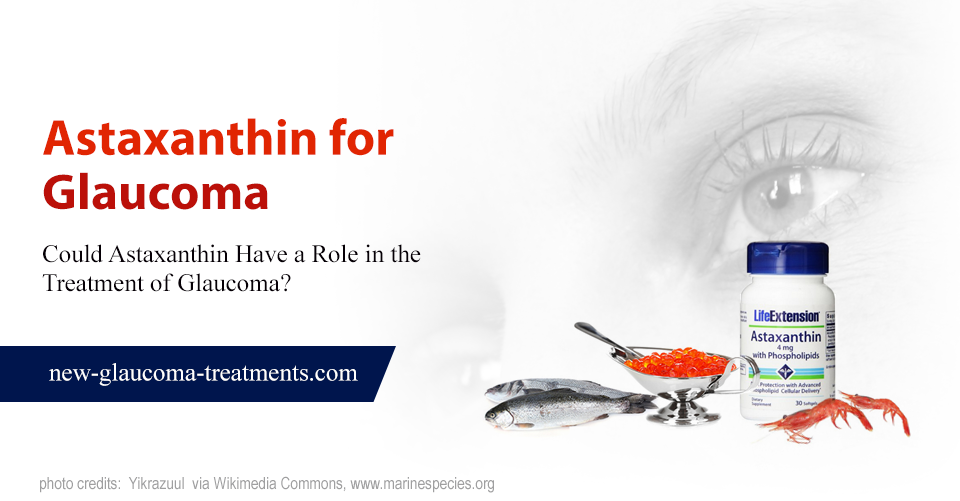 What is Astaxanthin?
What is Astaxanthin?
Astaxanthin is a member of the class of molecules termed carotenoids. It is naturally found in certain species of microalgae, salmon, trout, shrimp, lobster, fish eggs, and a number of bird species.[1] Similar to beta-carotene, it has antioxidant properties. In fact, it may even be a more powerful anti-oxidant than beta-carotene.[2]
Evidence that Astaxanthin can be effective in the treatment of Glaucoma
In one laboratory study rats with experimentally induced elevated IOP were given astaxanthin in doses well beyond what would normally be consumed by humans. In those rats receiving astaxanthin, the retina was both functionally and microscopically less damaged than in the rats that received no astaxanthin.
Although these results are encouraging, no one knows if it is safe for humans to take astaxanthin in such high doses for any period of time. Hopefully human trials will be conducted both to confirm the benefit as well as to suggest a proper dose.
Potential Side Effects and Risks
Astaxanthin is “generally recognized as safe” when taken in amounts commonly found in foods.[3] Additionally, up to 4mg per day has been well-tolerated even when taken with other carotenoids for up to 12 months.[4] Up to 10 times that amount has been well-tolerated without significant side effects, but for shorter periods of time.[5]
It should be noted, however, that a similar molecule, canthaxanthin, has been associated with loss of vision due to crystal formation in the retina.[6] As such, anyone taking astaxanthin who notes vision loss should immediately discontinue astaxanthin.
Also of note is that supplementation with the carotenoid beta-carotene has been associated with an increased risk of lung cancer. As astaxanthin is a carotenoid its use should probably be avoided by those who are active or have been active smokers.
Recommended Dosage
As no human glaucoma studies have been done looking at the role of astaxanthin, it is not possible to recommend a proper dosage.
Where to Buy
As with most supplements, cost can vary widely. Take note, however, that the quality can vary as much as the price. To be certain you are getting a high quality product I would recommend you only purchase supplements such as astaxanthin from a trusted brand such as Life Extension.
References:
1) Goodwin TW. Metabolism, nutrition, and function of carotenoids. Annu Rev Nutr 1986;6:273-97.
Kobayashi M, Kakizono T, Nishio N, et al. Antioxidant role of astaxanthin in the green alga Haematococcus pluvialis. Appl Microbiol Biotechnol 1997;48:351-6.
2) http://www.astaxanthin.org.
3) Electronic Code of Federal Regulations. Title 21. Part 182 — Substances Generally Recognized As Safe. Available at: 786bafc6f6343634fbf79fcdca7061e1&rgn=div5&view= text&node=21:3.0.1.1.13&idno=21
4) Parisi V, Tedeschi M, Gallinaro G, et al. Carotenoids and antioxidants in age-related maculopathy italian study: multifocal electroretinogram modifications after 1 year. Ophthalmology 2008;115:324-33.
5) Comhaire FH, El Garem Y, Mahmoud A, et al. Combined conventional/antioxidant “Astaxanthin” treatment for male infertility: a double blind, randomized trial. Asian J Androl 2005;7:257-62.Yamashita E. The effect of a dietary supplement containing astaxanthin on skin condition. Carotenoid Sci. 2006;10:91-95.
Andersen LP, Holck S, Kupcinskas L, et al. Gastric inflammatory markers and interleukins in patients with functional dyspepsia treated with astaxanthin. FEMS Immunol.Med Microbiol. 2007;50:244-48.
Kupcinskas L, Lafolie P, Lignell A, et al. Efficacy of the natural antioxidant astaxanthin in the treatment of functional dyspepsia in patients with or without Helicobacter pylori infection: A prospective, randomized, double blind, and placebo-controlled study. Phytomedicine. 2008;15:391-99..
Yoshida H, Yanai H, Ito K, Tomono Y, et al. Administration of natural astaxanthin increases serum HDL-cholesterol and adiponectin in subjects with mild hyperlipidemia. Atherosclerosis 2010;209:520-23.
6) Espaillat A, Aiello LP, Arrig PG, et al. Canthaxanthin retinopathy. Arch Ophthalmol 1999;117:412-3.


